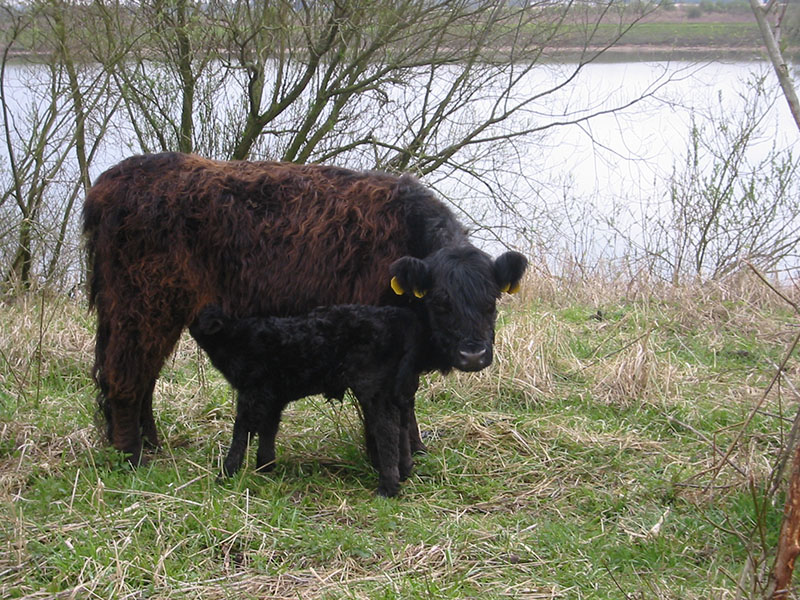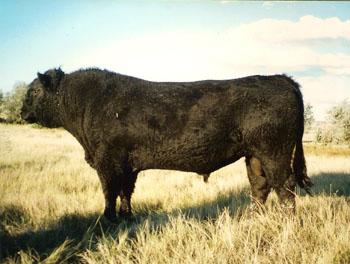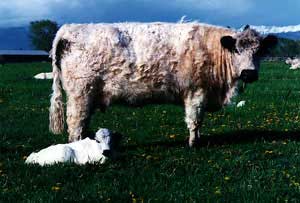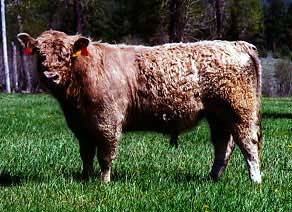Galloway Cattle
Historian's writings differ somewhat, but upon three points  they generally agree regarding the origin of the Galloway. The breed is recognized
to be a very ancient one, with obscure origins shrouded in antiquity and its' name
derived from the word Gallovid or Gaul. The Gauls were the native inhabitants of the
regality known as the Province of Galloway. This province once comprised six shires
(counties); Dumfries, Lanark, Renfew, Ayr, Kirkcudbright and Wigtown in the very southernmost
extremity of Scotland's Lowlands. The cattle of the region were said to be dark, smooth-polled,
wavy-haired with undercoats like beaver's fur and for centuries they went unnamed,
referred to only as the black cattle of Galloway. From this coastal environment of
winds and damp cold, combined with an undulating terrain of moors, granitic hills,
heathery mountain ranges and fertile glens emerged the Galloway breed of cattle.
they generally agree regarding the origin of the Galloway. The breed is recognized
to be a very ancient one, with obscure origins shrouded in antiquity and its' name
derived from the word Gallovid or Gaul. The Gauls were the native inhabitants of the
regality known as the Province of Galloway. This province once comprised six shires
(counties); Dumfries, Lanark, Renfew, Ayr, Kirkcudbright and Wigtown in the very southernmost
extremity of Scotland's Lowlands. The cattle of the region were said to be dark, smooth-polled,
wavy-haired with undercoats like beaver's fur and for centuries they went unnamed,
referred to only as the black cattle of Galloway. From this coastal environment of
winds and damp cold, combined with an undulating terrain of moors, granitic hills,
heathery mountain ranges and fertile glens emerged the Galloway breed of cattle.
Though much has been written of the history of British cattle since the middle of the 18th century, the period immediately before that is almost without a record. Historian Hector Boece (1570), writing about the Galloway, says, "In this region ar mony fair ky and oxin of qubilk the flesh is right delicious and tender." Ortelius, the historian writing in 1573, says, "In Carrick (then part of Galloway) are oxen of large size, whose flesh is tender, sweet and juicy."
 The Galloway breed of cattle became important during the Scoto-Saxon period, and the
breeders of Galloway enjoyed the export of cheese and hides. Later the cattle were
sold in considerable numbers to English farmers who sent them to Smithfield market
after a fattening period on English grass. It is said that the Galloway breed was
never crossed with the other breeds. It is not known where the polled character was
acquired by the Galloway breed because in its beginning many of the cattle were horned.
However, many writers during the last part of the 1700s and early 1800s mentioned
polled Galloway cattle, and the breeders decided they liked the polled characteristic
and started selecting their cattle for the character. Most of the early cattle in
the Galloway district were black, but red, brown, brindle, and cattle with white markings
were not uncommon.
The Galloway breed of cattle became important during the Scoto-Saxon period, and the
breeders of Galloway enjoyed the export of cheese and hides. Later the cattle were
sold in considerable numbers to English farmers who sent them to Smithfield market
after a fattening period on English grass. It is said that the Galloway breed was
never crossed with the other breeds. It is not known where the polled character was
acquired by the Galloway breed because in its beginning many of the cattle were horned.
However, many writers during the last part of the 1700s and early 1800s mentioned
polled Galloway cattle, and the breeders decided they liked the polled characteristic
and started selecting their cattle for the character. Most of the early cattle in
the Galloway district were black, but red, brown, brindle, and cattle with white markings
were not uncommon.
In 1851, a fire at the Highland Agricultural Museum at Edinburgh destroyed all the historical records and pedigrees of the Galloway collected prior to that time. Eleven years later (1862), a Polled Herd Book was published and it included the Galloway, Aberdeen, and Angus breeds. In 1878 the Galloway Cattle Society of Great Britain initiated its own volume of pedigrees. The first exportation of Galloways to North America came in 1853 to the Graham brothers of Toronto, Canada. Michigan State College, Lansing, imported the first Galloways to America in 1866. The American Galloway Breeders' Association organized in 1882 and Volume I of the North American Galloway Herd, published in 1883, listed American and Canadian Galloways.
William McCombie, (pioneer Scottish Angus & Shorthorn breeder) said, "The Galloway undoubtedly has many great qualifications. On poor land they are unrivaled, on land so poor our Aberdeens could not subsist upon it. There is no other breed worth more by the pound weight than a first-class Galloway."
Characteristics
 The most visible characteristic of the Galloway is their long hair coat. Serving a
dual purpose, the coarse outer coat sheds wind and rain, while the soft, fur-like
under coat provides insulation and waterproofing. The color of the coat ranges from
the more popular Black, to Dun (silver through brown), Red, White (with dark pigment
about the eyes, nose, ears and teats), and the Belted (black, dun or red, with a white
band around the middle).
The most visible characteristic of the Galloway is their long hair coat. Serving a
dual purpose, the coarse outer coat sheds wind and rain, while the soft, fur-like
under coat provides insulation and waterproofing. The color of the coat ranges from
the more popular Black, to Dun (silver through brown), Red, White (with dark pigment
about the eyes, nose, ears and teats), and the Belted (black, dun or red, with a white
band around the middle).
Mature bull weights range from 1,700 to 2,300 pounds with an average being 1,800 pounds. The mature cow generally weighs from 1,000 to 1,500 pounds with the average being around 1, 250 pounds. Calf birth weights average from 75-80 pounds.
"Galloway cattle are generally very docile," quotes William Youatt, (English researcher, scientist, veterinary surgeon, historian & standard writer on cattle in the early 1800s.) He goes on to say, "This is a most valuable point about them in every respect. It is rare to find even a bull furious or troublesome." Galloways are very courageous however, and if annoyed by dogs or wild animals, they will act in concert, by forming a crescent and jointly attacking. There are claims that one or two Galloways in a field of sheep prevent any danger from dogs.
What Does the Galloway Breed Offer Today's Beef Industry?
 The Galloway, unrivaled as a grazing breed, utilizes coarse grasses and browse frequently
shunned by other breeds. Furthermore, their ability to produce a high quality beef
product directly from grass, has true economic value in that it is not necessary to
feed grains to 'finish' them. The Galloway steer, whether grass or grain fattened,
can produce the ideal 600-750 pound carcass.
The Galloway, unrivaled as a grazing breed, utilizes coarse grasses and browse frequently
shunned by other breeds. Furthermore, their ability to produce a high quality beef
product directly from grass, has true economic value in that it is not necessary to
feed grains to 'finish' them. The Galloway steer, whether grass or grain fattened,
can produce the ideal 600-750 pound carcass.
The Galloway is a maternal breed. The cows are easy calvers, while the calves themselves are hardy, vigorous and have a 'will to live' that gets them up and nursing quickly. The Galloway is long-lived, with many cows producing regularly into their teens and beyond. This trait alone can determine much of the economics and efficiency of any cattle operation.
Due to the breed's naturally dense, insulating hair coat the Galloway does not layer on excessive outside fat, which would only end up on the butcher's floor at slaughter time. Results of a multi-breed research project conducted by a Canadian Government Experiment Station, reveal that the Galloway ranks second only to the Buffalo in hair density tests. The robust, hardy nature of the Galloway has never been disputed. Though considered a breed for northern climates, the Galloway has been found to acclimate amazingly well to warmer regions.
The claim that Galloway beef is juicy, tender, and flavorful is substantiated in recent USDA tests of Galloway crossbreds, when compared with eleven other breeds. Results of the Cycle IV Germ Plasm Evaluation (GPE) Program at the USDA Meat Animal Research Center (MARC), Clay Center, Nebraska, showed the Galloway crosses placing at the top of the chart for flavor, juiciness and tenderness.
Today's Galloway breeder recognizes current beef industry trends, seeing the Galloway's potential role in crossbreeding and composite breed programs. The American Galloway Breeders' Association attuned to industry needs, offers an Appendix Registry system in addition to and kept separately from their purebred registry program. Both systems, as well as the EPD program are computerized. Additionally, the AGBA sponsors a National Show and Sale, hold annually in conjunction with their Convention, the third week of October, in Billings, Montana. Additionally, the AGBA arranges for ultrasound measurements for carcass traits, as well as measurements for frame size, pelvic capacity and scrotal circumference.
Registries and Breed Associations
Australia
Australian Galloway Association Inc
PO Box 531
Wodonga
VIC
3689
Phone: 02 6027 3361
Email: globex@albury.net.au
Galloway Cattle and Beef Marketing
Contact: The President
Postal: Box 309, Hall, ACT, 2618
Email: gallowaycattlebeefmarketing@yahoo.com.au
Canada
Canadian Galloway Association
2417 Holly Lane
Ottawa, Ontario
K1V 0M7
Tel: 613-731-7110
Email: clrc@clrc.on.ca
Denmark
The Danish Galloway Cattle Society
Braendholtvej 91
4340 Toelloese
Denmark
France
UPRA Gasconne
Centre National Gascon
09100 Villeneuve du Paréage
FRANCE
Phone: 00 33 5 61 60 15 30
Germany
Bundesverband Deutscher Galloway-Züchter
Godesberger Allee 142-148
53175 Bonn
Germany
Email: j.plog@bauernverband.de
Great Britain & Ireland
The Galloway Cattle Society of Great Britain and Ireland
15 Newmarket Street
Castle Douglas
Kirkcudbrightshire
DG7 1HY
Scotland
Phone: (+44) 1556 502753
United States
American Galloway Breeders' Association
310 West Spruce
Missoula, Montana 59802
Phone: (406) 728-5719
References
Material written specifically for the Breeds of Livestock project, Patricia Pruitt, Publisher, The Galloway Press.
Phone: (406) 587-3031
Modern Breeds of Livestock, Hilton M. Briggs & Dinus M. Briggs, Fourth Edition (1980).
